March of the Machine Learning, Part 1
Welcome to the first week of March of the Machine card previews. Today, I'm going to introduce the Exploratory and Vision Design teams, start telling the story of March of the Machine's design, and then show off two preview cards. Hope that sounds fun.
Lean, Mean Designing Machines
Before I can talk about how we made the set, I'd like to start by introducing the teams (at least for the beginning part of the design—I'll introduce the Set Design team next week).
-
Click here to meet the Exploratory and Vision Design teams
-
As always, I have the lead of the Vision Design team introduce the Exploratory and Vision Design teams. In the case of March of the Machine, that person is me.
Chris Mooney (strong second – exploratory and vision)
Chris was scheduled to lead the vision design of Wilds of Eldraine (their first premier vision design lead), so I wanted them to be the strong second for the set to get some hands-on experience putting a file together. They fulfilled that role for all of exploratory design and the start of vision. We ended up starting Wilds of Eldraine's design a bit faster than expected (due to behind-the-scenes scheduling issues), so the position of strong second was passed onto Ari after Chris left the team to focus on Wilds of Eldraine. Chris was one of the finalists in Great Designer Search 3 and has been an invaluable member on numerous design teams. They have a great insight for seeing design ideas that are exciting but not obvious. I was glad to have them by my side for this design.
Ari Nieh (strong second – exploratory and vision)
Ari is also from Great Designer Search 3, which she won. Ari led vision design for The Brothers' War and has been on a lot of design teams, and I value her willingness to question everything and force the team to reevaluate decisions. It's easy in design to get locked into an idea and pursue it in place a potentially better idea that went left unexplored. March of the Machine was a major undertaking and needed that questioning more than the average design. Ari would stay on for some of set design to help transition the file.
Annie Sardelis (exploratory)
Annie transitioned from the Creative team to design, and I wanted to expose her to the various parts of design. She would go on to lead the vision design for "Swimming" (coming out in 2024). Annie approaches every design team with an enthusiastic vigor and has insights that always help us push the design in new and exciting directions. March of the Machine was a big ask (as you'll see), so I was happy the Exploratory team had her unique vantage point.
Dan Musser (vision)
Dan is the play designer on most Vision Design teams. He's gotten very good at determining whether a mechanic will be something that can be balanced down the road. It's easy to get cool ideas that functionally won't work, so you want your Vision Design team to have someone that can point out future pitfalls. That's Dan's job, and he does it well.
Dave Humpherys (vision)
Dave was the set design lead for March of the Machine. When he leads the set design, he likes to be on the Vision Design team. He and I have worked together on several sets (Amonkhet, Ikoria: Lair of Behemoths, Dominaria, War of the Spark, and Kamigawa: Neon Dynasty), and we have a great working relationship. Dave is good about letting the Vision Design team follow the path it wants while raising concerns to ensure we're delivering something he can turn into a great set.
Mike Mearls (exploratory and vision)
Mike came to Magic from Dungeons & Dragons. This was the first premier set he worked on. March of the Machine was large in scope and very focused on the various planes of the Multiverse. Mike provided a different vantage point for how to think of the larger conflict and the way to view the different planes. It was nice to have someone who honed their game-design chops on a different game bring that expertise to the design.
Mark Rosewater (lead – exploratory and vision)
And then there was me. I knew March of the Machine was a major design challenge, so it didn't feel right inflicting the vision design upon any of my other designers. As you will see, it was a crazy design ask.
Cogs in the Machine
Each individual set has its own story, but we like to make larger overarching stories that take place over several years. With the Bolas arc, we decided to try something new. We designed a top-down set to tell the final chapter of the giant storyline. I called it an "event set." For the Bolas arc, that set was War of the Spark. It ended with a conflict that involved almost every known Planeswalker fighting Bolas and his army of Eternals on Ravnica.
War of the Spark was a bold ask. Most sets only have a handful of planeswalker cards, so telling a story of a giant Planeswalker war was daunting. But it made for an amazing story conclusion, so we figured out how to make a set that represented it. March of the Machine was the event set for the Phyrexian arc. And like War of the Spark, the Creative team had very grandiose ideas for what the set represented.
Here, with plenty of dramatic license, is me first hearing about the set's story. Doug Beyer oversees the story and worldbuilding (however, I'd like to stress that there are many people who worked hard to make it):
Me: Okay, so the Phyrexians figure out how to get off New Phyrexia, and then what?
Doug: They invade.
Me: Invade what?
Doug: Invade the Multiverse.
Me: Which plane do they invade?
Doug: It's not just one plane.
Me: Okay, which planes do they invade?
Doug: All of them.
Me: So, what does "all of them" really mean? Like five to ten?
Doug: No, all of them. Every plane we've ever referenced in any Magic set or Magic-related product.
Me: So, thousands of planes? Hundreds of planes? I'm not sure quite how big the Multiverse is.
Doug: We'll probably focus more on the planes we've visited.
Me: So, tens of planes?
Doug: Yes.
Me: It kind of makes a war of Planeswalkers seem quaint.
I won't lie, it was an idea so large in scope, it was a bit daunting, but you don't make Magic sets for 28 years if you don't enjoy a challenge. The key for me, and the rest of the design team, was to get a hook we liked about it. What was the essence of the design? Luckily, it came to me early in exploratory design. I used an analogy to explain it to everyone. Planes were going to be to March of the Machine what Planeswalkers were to War of the Spark.
Okay, what did that mean exactly? It meant that I wanted the mechanical definition of the set to be focused through the lens of the various planes. We spent a lot of time in exploratory design figuring out what that meant. Ultimately, we wanted players to have the ability to pick their favorite plane and get a chance to see it shine in the set. This led me to the idea of having a new card type that represented the planes. Planechase had plane cards that represented various places on different planes. I was interested in something that represented the entirety of the plane.
Also, we needed to play up the story, which was a giant war between all the denizens of the Multiverse and the Phyrexians. Again, we wanted the focus of this war to be through the lens of the various planes. We accomplished this by focusing on the different planes fighting back. The idea was that whenever you saw an individual card, assuming you were up on all the planes, you could tell which plane it was from. We chose to make about 70% of the creatures represent the Coalition (that's what we called them, borrowed from Invasion when the Phyrexians invaded Dominaria—invading just one plane, how quaint; it's not officially canon or anything).
This meant that around 30% of the creatures were going to be Phyrexians. We had two issues to solve for the Phyrexians. One, we had just made a set, Phyrexia: All Will Be One, filled with Phyrexians, and I wanted these Phyrexians to feel creatively connected but mechanically explore new space. Two, how could we make the Phyrexians such that they also represented the lens of different planes?
The Exploratory Design team did a great job of raising all these questions, but the Vision Design team had to solve them.
Double-Face Your Fears
We wanted the Phyrexians to represent all the various planes. Luckily, their whole schtick is turning other creatures into them, so we made a list of creatures that were iconically from each plane. For example, if you saw a Phyrexian Samurai, you would know what plane it was from. Then it dawned on us that it would be even cooler to show off creatures in their natural forms on the planes before Phyrexianization. Transforming double-faced cards (TDFCs) would also solve another issue, that is, finding a way to make something that felt Phyrexian but wasn't in Phyrexia: All Will Be One. It wouldn't take us long to realize that we could also use this on legendary creatures. Nothing emotionally captured the trauma of a Phyrexian invasion than watching beloved characters get Phyrexianized. (Oh, Omnath.)

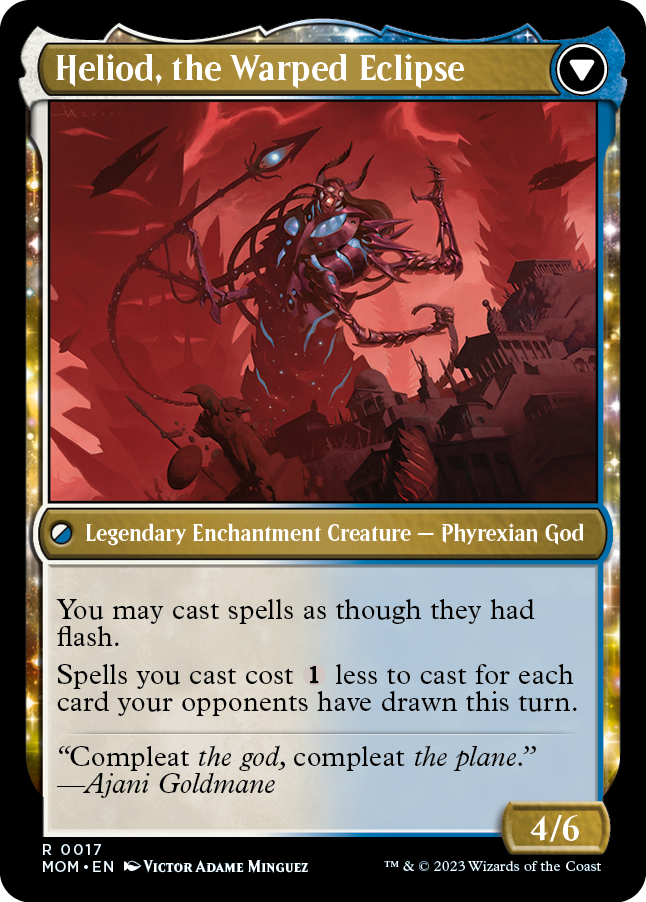
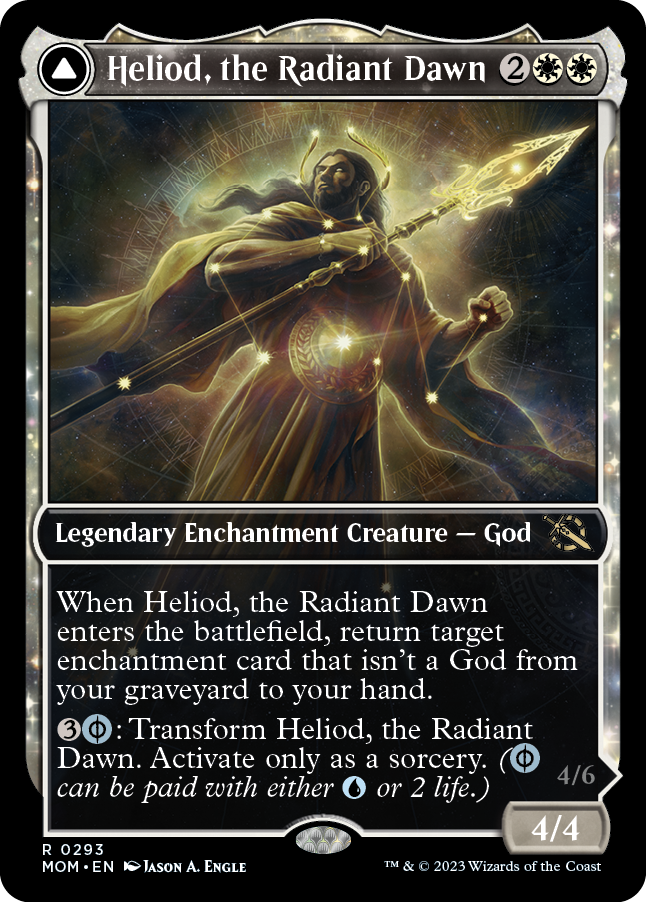
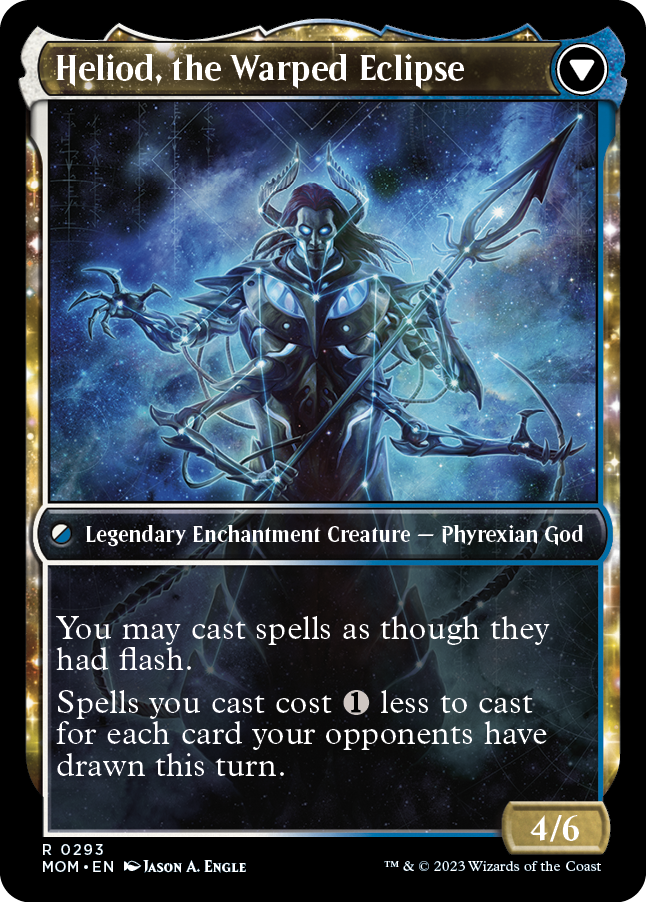
Once we had TDFCs in the set, it became a tool we could use elsewhere. The next idea we explored was making an artifact token that could create a Phyrexian creature token. Our best artifact tokens had been ones where once you had them, you then had to spend mana to get the resource (think Clues and Food). Having a cost allows us to be more generous with cards creating the token.
We liked the idea that what the Phyrexians were best at was making more Phyrexians. Our first stab at this idea, which we called cocoon in vision design (it's called incubate in the set), was a token that you could spend some amount of mana to create a 2/2 Phyrexian artifact creature. We then thought it would be even cooler if the size of that creature could vary, but we weren't sure how to do that. We didn't want every incubate token to require a different amount of mana to get the creature token. We also didn't want to make the players have to use two different tokens each time they used this mechanic. The solution rested in using the tool of double-faced cards.
First up, what if the noncreature artifact token that made the Phyrexian creature token was all on one card? Yes, we could have our first double-faced token (well, one where the sides work together mechanically). If that was the case, we could make use of +1/+1 counters. A transforming permanent keeps counters, and you can put +1/+1 counters on noncreatures (they just don't do anything until it becomes a creature). The mechanic would then create the token, noncreature artifact side up, and put a number of +1/+1 counters on it equal to the variable of the mechanic. Then there would be a locked cost, two generic mana, to transform it into the creature, which was on the back face. That would be a colorless Phyrexian artifact creature. There was some talk if the rules could handle a double-faced token, but we got it all worked out.
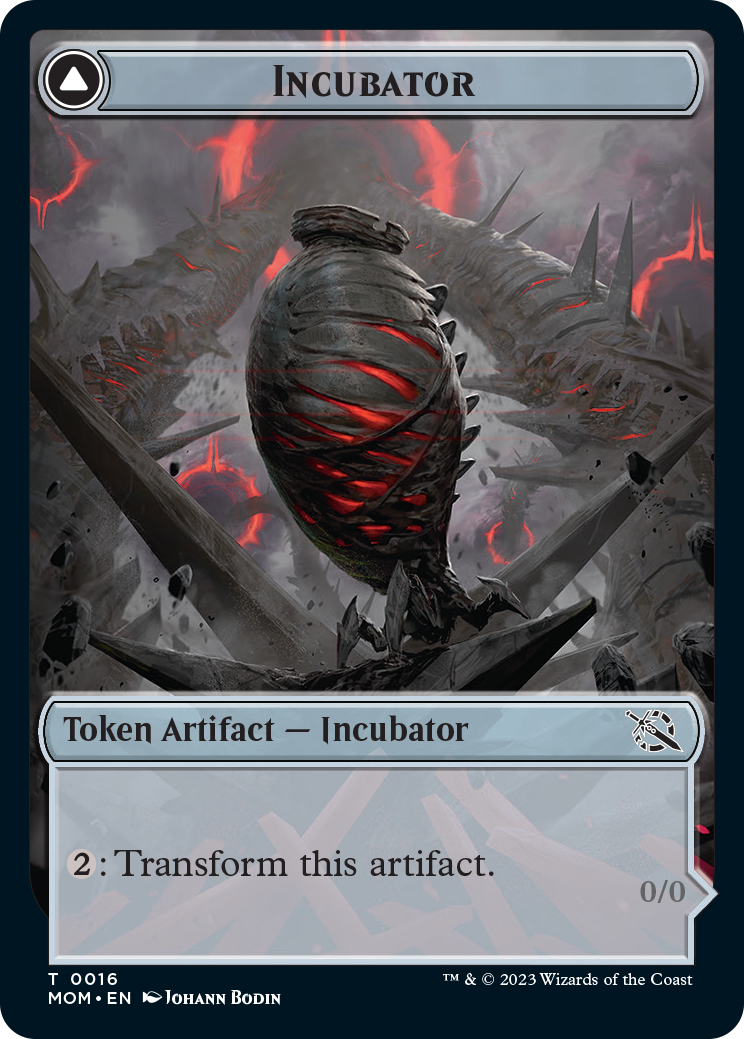
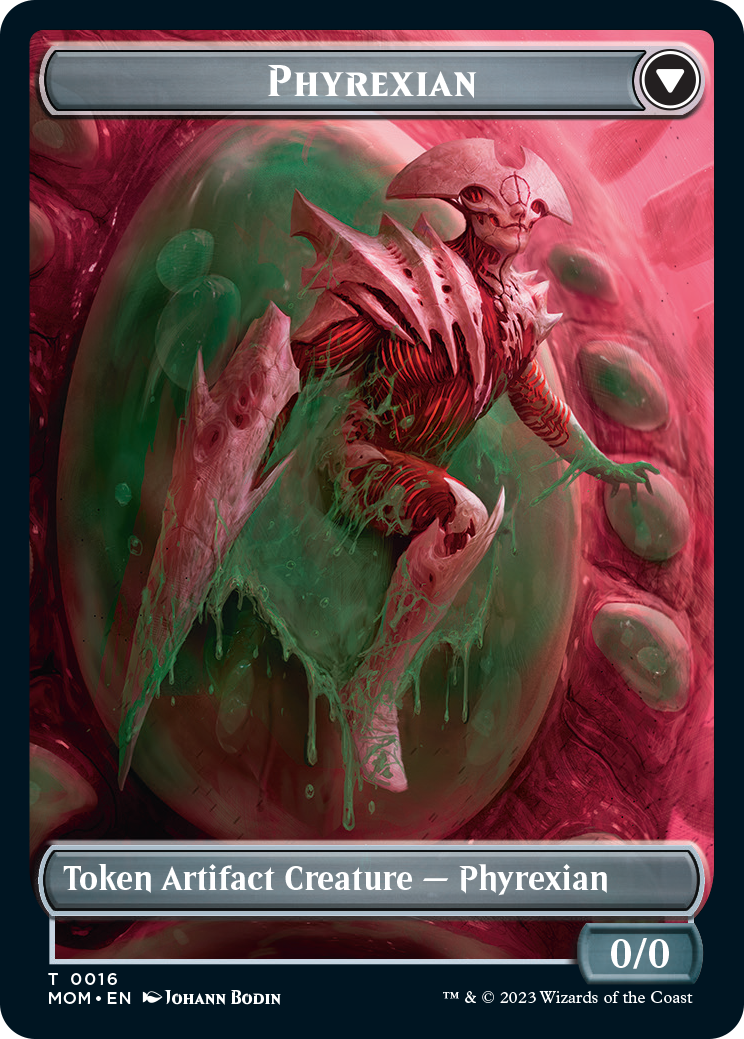
Next, we knew that the five Phyrexian Praetors were going to show up again (we felt the five main villains had to show up in the finale), so we wanted some novel way to represent them. We presented several different options to the Set Design team, most of which involved TDFCs. Set Design chose to use the Praetors that transformed into Sagas.
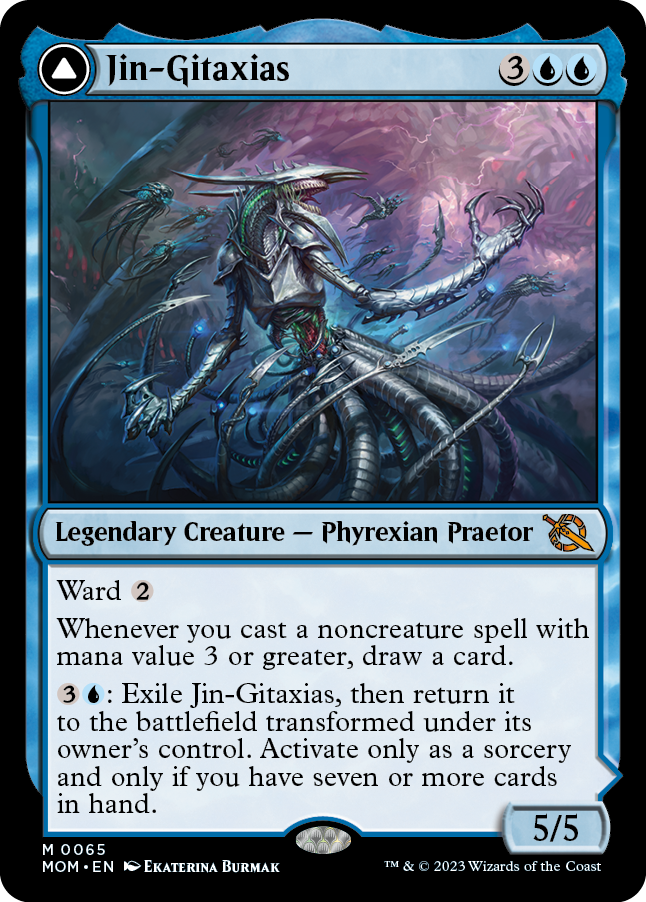
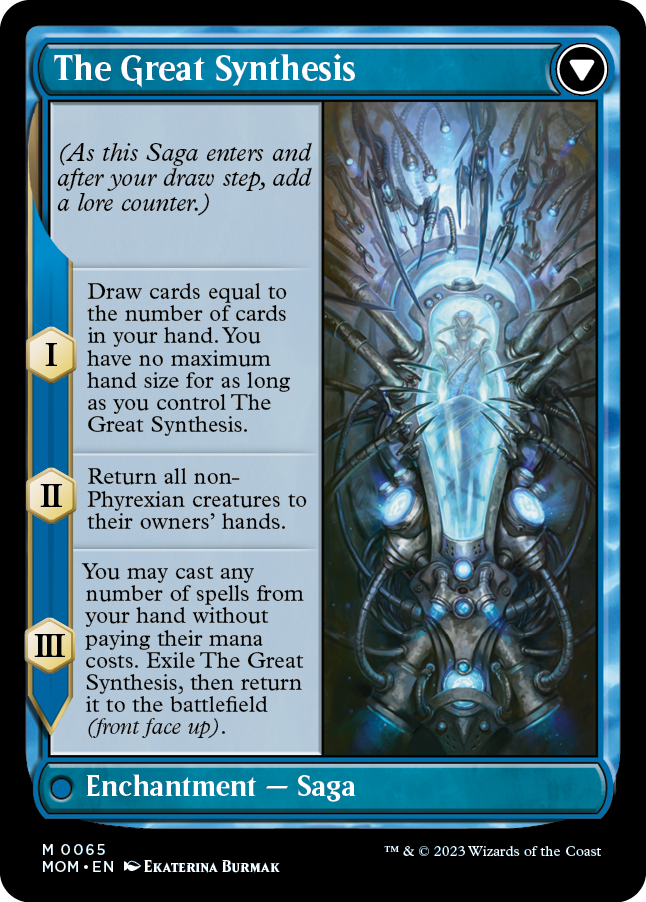
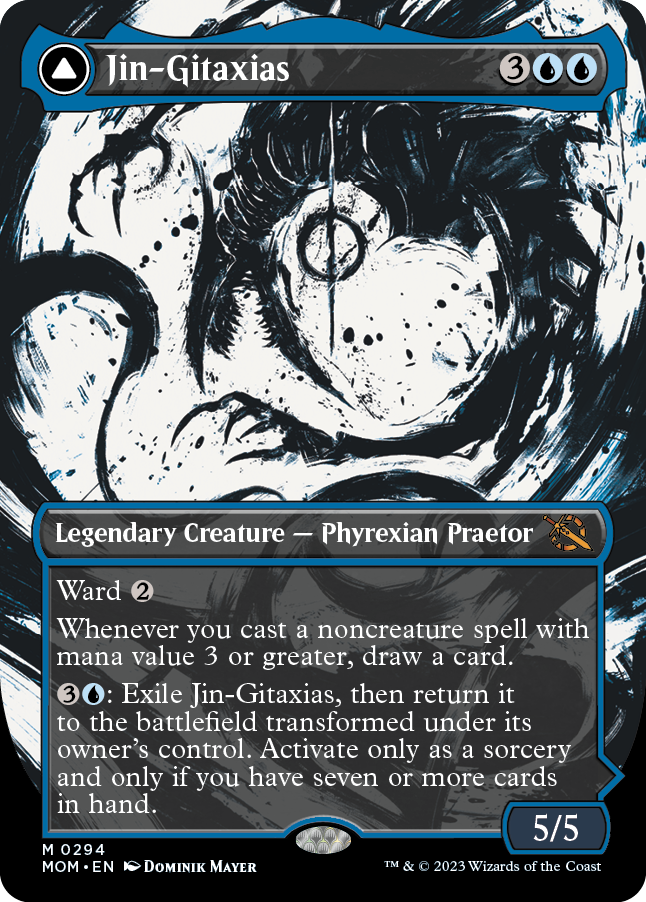
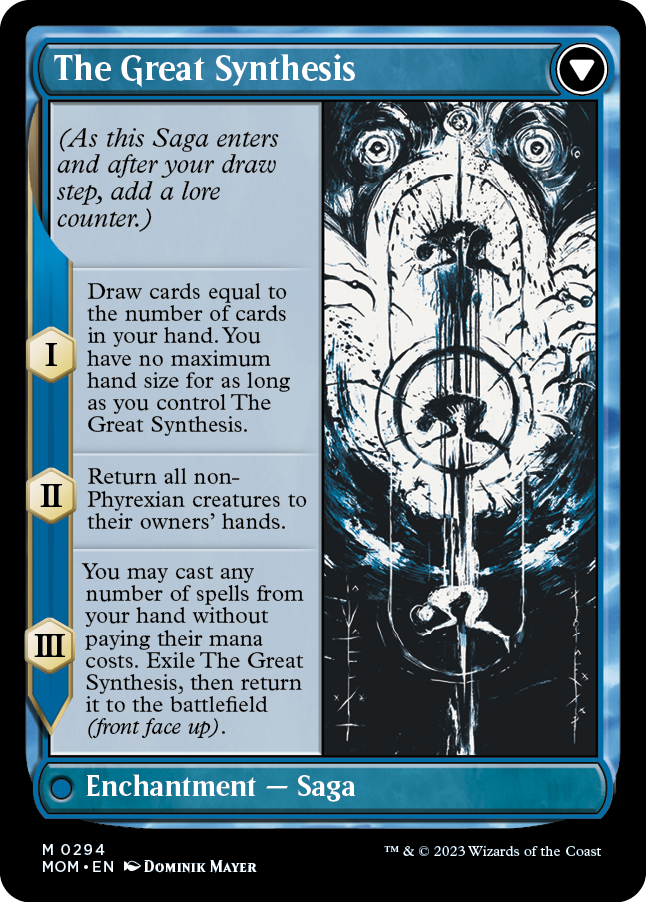
The use of TDFCs representing the Phyrexians allowed us to use "transformation matters" as a theme that runs through the Phyrexian side of the conflict. We also were able to make the Phyrexian creature type matter. Phyrexia: All Will Be One shied away from this because such a large percentage of the set was Phyrexian. TDFCs, transformation matters, and Phyrexians matter allowed us to give a distinct feel to the Phyrexian portion of the set that let it play nicely with the cards from Phyrexia: All Will Be One without feeling too similar in execution.
The final use of TDFCs tackled that new card type idea I was eager to explore. Here's where we started: I wanted each plane to have its own card, and I didn't want more than one card representing each plane. I didn't know whether it had to represent the plane as a whole or the battle the plane was going through. Interestingly, we started focusing on the former and ended up focusing on the latter.
The earliest version of battles were called "planes" (yes, we knew that the Planechase cards were called planes, but we weren't worrying about what to officially call them yet). We tried a whole bunch of different things. Here are a bunch that we tried:
- Permanents that sat on the battlefield granting you a repeatable ability you could use once per turn and a larger ability that sacrificed the plane.
- Permanents that came in a three-card pile, allowing you to move between them.
- Permanents that you put a counter on that represented you and granted you abilities if you were on that plane. You were then allowed to move between planes once per turn.
- Permanents that came from a different deck and sat on the battlefield, granting you abilities. Only one was active at a time.
- Permanents that granted an ability you got every turn. It then gained counters, leading to a large effect when you reached a certain threshold.
The version we handed off at end of vision design looked like this:
Portal to Amonkhet
Land — Desert
CARDNAME enters the battlefield tapped.
T: Add B.
2B, T: Exile CARDNAME and return it to the battlefield transformed. Then planeswalk to CARDNAME. It loses non-mana abilities once it has no loyalty. Activate only as a sorcery.
\\
Amonkhet, the Plane
Land — Desert Plane
T: Add B.
Whenever a creature you control becomes blocked, defending player loses 1 life.
4B, T: Planeswalk to CARDNAME.
Whenever you planeswalk here, create a 2/2 white Zombie creature token.
Loyalty 2
It was a land. Plane was a land subtype that appeared on the back of the card. The front always provided mana and gave you an activation, usually involving mana, that allowed you to transform the card to its plane side. The plane face would grant you a static ability and an activated ability. Also, there was a one-time effect when you "planeswalked" to that face. The plane had a loyalty that functioned like planeswalkers, where your opponent could attack the plane to shut off its non-mana ability.
This is not remotely how the battles ended up, but that's a story for next week as I get into set design. One of my preview cards is a battle, so you can see the final form and imagine how we went from the above to the final design.
-
Click here to see Invasion of Dominaria // Serra Faithkeeper
-
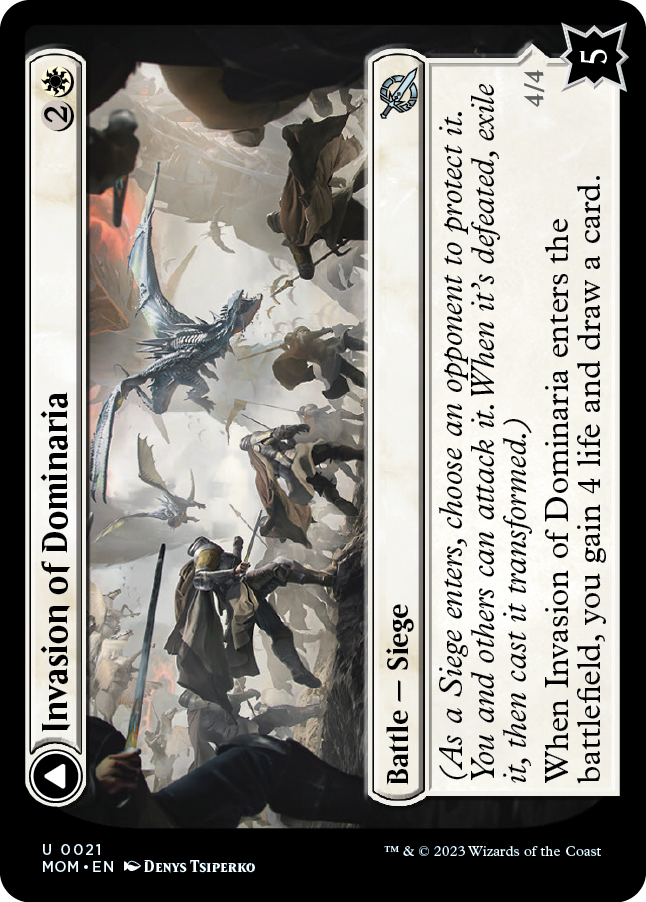
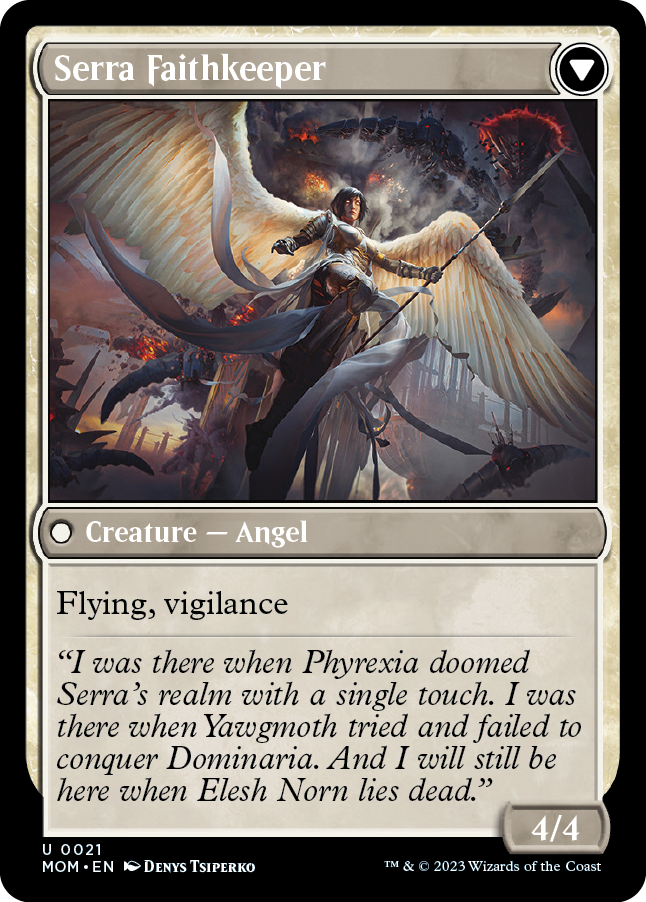 Invasion of Dominaria // Serra Faithkeeper
Invasion of Dominaria // Serra FaithkeeperThere are a few traces of the original design in the final execution. Each plane (of the ones we chose to do—most of the ones players know) has only one card. The cards are double faced, and players do attack them. Other than that, a lot changed. I'll walk you through it all next week.
Multiverse, Same as the First
Representing the Phyrexians and the battle for each plane was a big part of the design, but we still had to represent the denizens of the Multiverse who were fighting the Phyrexians. As I said above, most of the set focused on the defenders rather than the attackers. The big question: how do we represent them?
We decided that the key trait we wanted to play up was cooperation. Nothing brings people together like a shared enemy. To capture this sense of working together, we ended up using two mechanics. One was a returning mechanic, and the other was new. The returning mechanic was convoke. Convoke was created by Richard Garfield to represent the Boros guild in the design of original Ravnica. I liked the mechanic but made one slight change. I made it the Selesnya mechanic because Selesnya is all about working together.
Convoke was well received. It returned in Future Sight (along with most other mechanics). We then used it as the sole returning mechanic in Magic 2015. It was the only returning guild mechanic in Guilds of Ravnica. We also used it well in the first Modern Horizons. We arrived at convoke by making a giant list of every existing mechanic that might capture the teamwork flavor we wanted. We narrowed the list down to a more manageable size and then let the team vote on which one they wanted to use most (with the idea that we'd explore them in order of preference). Convoke won handily, so we decided to try it first. We put it in the set and, it was such a slam dunk, we never looked back.
The other mechanic went through a few more paces to make it to print. Backup (called boost in design) was created by Ari Nieh to make creatures interact with one another. All backup creatures have an ability that they can grant to another creature for the turn. The backup ability comes with a number. When a creature with backup N enters the battlefield, you then put N +1/+1 counters on target creature. If that creature is different from the creature with backup, it grants all its abilities to that other creature for the turn. Here's the actual text:
Backup N (When this creature enters the battlefield, put N +1/+1 counters on target creature. If that's another creature, it gains the following ability until end of turn.)
N represents a number. In the set, that number is 1 or 2. We experimented with higher backup numbers, but it made the mechanic more about the +1/+1 counters than granting the ability. Getting the right balance so you're encouraged to pick other creatures a lot of the time, but not always, was an interesting challenge for the Set and Play Design teams.
The other idea, one that came all the way from exploratory design, was team-up legendary creatures. I believe it came from trying to solve two different problems. One, we wanted a way to communicate that this was different than a normal conflict, something larger in scope. Two, March of the Machine takes place on every plane, so we wanted to get as many named characters on cards as possible. This way, the weight of the situation came through in showing two characters who would normally never work together joining forces against a shared enemy. It also let us double the number of characters featured on legendary creature cards.
Our original pitch consisted of having creatures from different planes team up, but that wasn't how the conflict worked according to the Creative team. The Phyrexians were the ones crossing between planes, so we ended up picking two creatures from the same plane that felt like a quirky pairing. The Vision Design team also offered up the idea that we could have a bonus sheet to show off other cool elements of the planes fighting off the Phyrexians. More on that next week.
There were several other suggestions that Vision Design made as means to show off the conflict that didn't see print. I'll talk about those when I show off the vision design handoff document for March of the Machine.
That about does it for the design story up through vision design, but before I leave for today, I have one more preview card to show off:
-
Click here to meet Zhalfirin Lancer
-
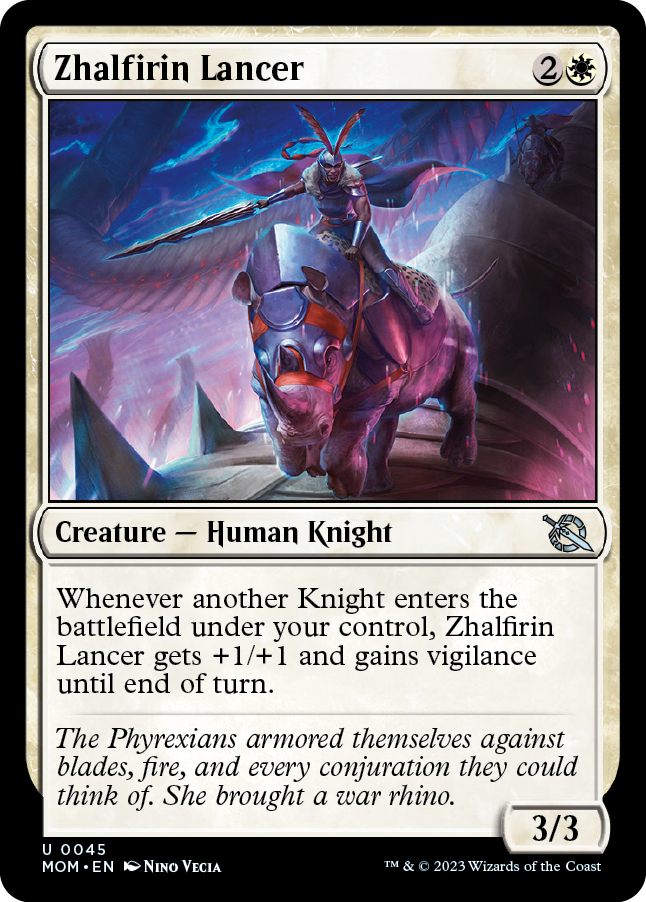 Zhalfirin Lancer
Zhalfirin LancerThis card shows off two different things, one mechanical and one creative. Mechanically, this card cares about Knights. This is a small creature type theme that runs through the white-blue draft archetype. When thinking about how we could show different planes fighting off invaders, it dawned on us that it might be cool to show all the different Knights from the different planes, as a lot of Magic planes have Knights. We liked the idea of showing off the planes through how they all executed a similar idea differently.
Creatively, you'll notice the name Zhalfirin. Zhalfir was the land that Teferi phased out to save from the Phyrexians (all the way back in Mirage block) that he's been unable to phase back in. This has been a big storyline for Teferi. Well, if you read the stories of March of the Machine, you'll see Zhalfir plays a big role.
That's all the time I have for today. As always, I'm eager for any feedback, be it on today's article, any of the mechanics I talked about, or on March of the Machine itself. You can email me or contact me through my social media accounts (Twitter, Tumblr, Instagram, and TikTok).
Join me next week when I walk through the story of March of the Machine's set design.
Until then, may you keep the Multiverse safe from the threat of the Phyrexians.

